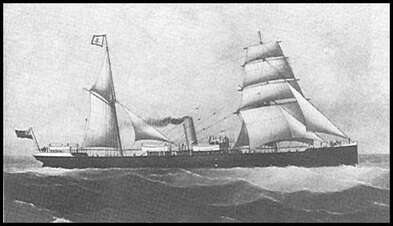Steamer City of Portland Wrecked Of Maine Coast
By James Donahue
An estimated 70 passengers escaped injury after the steamship City of Portland wrecked on a shoal off Rockland, Maine, during the early morning hours of May 8, 1884.
The 1,000-ton vessel, with a Captain Lareom in command, was steaming from Boston to St. John, New-Brunswick, and had just made a stop at Portland, Maine, when the accident happened at Northwest Ledge, at Owl’s Head, at 3:15 a.m.
A story in a New York newspaper said the steamer, owned and operated by the International Steamship Co. of Nova Scotia, was carrying about 70 passengers and about two-thirds its capacity in cargo, when it left Portland at 8:45 p.m. the previous day.
It was a clear night and Captain Lareom had retired to his cabin, leaving the pilot, J. A. Wheeler, at the helm. As the morning hours progressed, the weather became threatening. By the time the ship reached Manhegan, Wheeler altered course and chose to steer through Grindstone Channel, passing between Sheep and Fisherman’s Islands.
Wheeler appears to have made two serious mistakes in judgment that morning. He altered the ship’s course without informing the captain, and he did not check the speed of the vessel during its passage through the channel.
The lookout, a man named Bibber, correctly spotted the buoy that marked the channel, but unknown to the crew, the buoy was not in its proper place. Because the ship was running at a full speed of 12 knots, the crew was not dropping depth lines as a precaution against trouble. Consequently, the City of Portland crashed at full speed driving its wooden hull right on top of Grindstone Ledge before coming to an abrupt stop.
The ship was an obvious wreck. Because it was hard on the rocks, it did not slide back into deep water to sink, thus giving the crew and passengers time to escape.
The mate took crew members in a yawl boat to Rockland, some six miles away, to get help. By 6:30 a.m. the steamer Rockland was at the scene, as was an unidentified sloop from Owl’s Head. Two small boats transferred the women and children to the sloop and the rest of the passengers, plus baggage and express freight, were taken aboard the Rockland.
Even as the rescues were being made, the seas were rising and a storm was moving in. By late in the day high seas were pounding the wreck, tearing away much of the superstructure. Eventually the ship was dashed to wreckage.
By James Donahue
An estimated 70 passengers escaped injury after the steamship City of Portland wrecked on a shoal off Rockland, Maine, during the early morning hours of May 8, 1884.
The 1,000-ton vessel, with a Captain Lareom in command, was steaming from Boston to St. John, New-Brunswick, and had just made a stop at Portland, Maine, when the accident happened at Northwest Ledge, at Owl’s Head, at 3:15 a.m.
A story in a New York newspaper said the steamer, owned and operated by the International Steamship Co. of Nova Scotia, was carrying about 70 passengers and about two-thirds its capacity in cargo, when it left Portland at 8:45 p.m. the previous day.
It was a clear night and Captain Lareom had retired to his cabin, leaving the pilot, J. A. Wheeler, at the helm. As the morning hours progressed, the weather became threatening. By the time the ship reached Manhegan, Wheeler altered course and chose to steer through Grindstone Channel, passing between Sheep and Fisherman’s Islands.
Wheeler appears to have made two serious mistakes in judgment that morning. He altered the ship’s course without informing the captain, and he did not check the speed of the vessel during its passage through the channel.
The lookout, a man named Bibber, correctly spotted the buoy that marked the channel, but unknown to the crew, the buoy was not in its proper place. Because the ship was running at a full speed of 12 knots, the crew was not dropping depth lines as a precaution against trouble. Consequently, the City of Portland crashed at full speed driving its wooden hull right on top of Grindstone Ledge before coming to an abrupt stop.
The ship was an obvious wreck. Because it was hard on the rocks, it did not slide back into deep water to sink, thus giving the crew and passengers time to escape.
The mate took crew members in a yawl boat to Rockland, some six miles away, to get help. By 6:30 a.m. the steamer Rockland was at the scene, as was an unidentified sloop from Owl’s Head. Two small boats transferred the women and children to the sloop and the rest of the passengers, plus baggage and express freight, were taken aboard the Rockland.
Even as the rescues were being made, the seas were rising and a storm was moving in. By late in the day high seas were pounding the wreck, tearing away much of the superstructure. Eventually the ship was dashed to wreckage.
